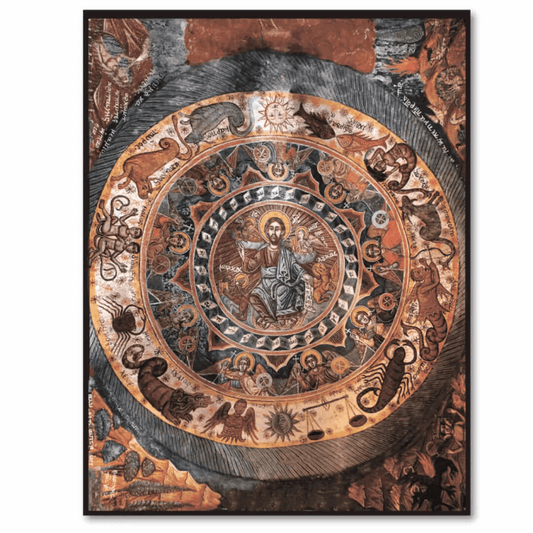Saint Nicholas the Wonderworker, Bishop of Myra in Lycia. Wooden orthodox icon.
Saint Nicholas the Wonderworker, Bishop of Myra in Lycia. Wooden orthodox icon.
Couldn't load pickup availability
Saint Nicholas the Wonderworker, Bishop of Myra in Lycia. Wooden orthodox icon.
The original icon is from the late 17th century. It is kept in the Museum of Fine Arts of Tatarstan.
Saint Nicholas the Wonderworker is one of the most revered saints in Christian culture. He was an archbishop in the city of Myra in Lycia and became famous for his numerous miracles. People pray to him, asking for protection from troubles and help in traveling.
In 1877, Kazan researcher Platon Zarinsky in his work "Church Antiquities of Kazan" drew attention to two icons of the warm church of the Zilant Monastery, one of which was the image of Saint Nicholas the Wonderworker. In his opinion, the features of this icon were "ornaments along the field and edges" and "bright colors".
The author of the icon was an unknown master of the second half of the 17th century. The antiquity of the image of St. Nicholas the Wonderworker from the Zilant Monastery is evidenced by the style of the icon: the face with a characteristic cut of the eyes, a thin nose, a high forehead and locks of hair above it, as well as rich and contrasting colors.
The originality of the icon's style is emphasized by a combination of unusual methods of processing the board. The artist used ornamental carving of several types, imitating a metal frame on the fields and on the background. At the same time, the plant ornament of the wheat field on the background echoes the image of the saint's eyebrows in the form of ears of corn.
The halo is filled with a plant pattern reminiscent of the multi-colored ornaments of decorative boards that covered the tyablas of ranks in iconostases. Tyablo (Greek τέμπλον - templon, altar barrier) is a wooden beam of the iconostasis decorated with plant or geometric ornaments for installing icons. In the Trinity Church, a chronicle (inscription) about the consecration of the temple was placed on the tyably. Similar ornaments on the saint's halo have been preserved on rare Balkan (14th century Athos icon from the collection of the Russian Museum) and Old Russian (1294 icon by Alexy Petrov, from the collection of the Novgorod Museum-Reserve) monuments. Ornamented halos are more often found in sculptural images of St. Nicholas of Mozhaisk.
To date, art historians do not know of similar monuments that would be distinguished by such a wealth of ornamentation and original artistic techniques.
🖼 Product Features
• Printed on durable MDF wood panel
• Mineral pigment inks for long-lasting color
• Sealed with protective beeswax finish
• Ready to hang — includes mounted metal hook
• Handmade by Orthodox Christian artisans
• Lightweight yet solid: board thickness is 1.6 cm (0.6")
📏 Available Sizes
• 12 x 15 cm (5” x 6”)
• 23 x 30 cm (9” x 12”)
• 30 x 39 cm (12” x 15”)
🎁 Perfect for
• Orthodox Christian gifts
• Spiritual housewarming gifts
• Prayer corners and devotional altars
• Baptisms, name days, and feast days
🌍 Ships worldwide with secure packaging
Our icons are made by Orthodox craftsmen in Portugal.
We hope it will be a good gift for you and your loved ones.
Share
Theological icons
-
The Holy Trinity by Andrei Rublev. Wooden orthodox icon
Regular price From $138.00 USDRegular priceUnit price / per -
Mother of God Virgin Mary the Theotokos Impenetrable Door (Impenetrable Gate). Wooden orthodox icon
Regular price From $138.00 USDRegular priceUnit price / per -
Icon of the Last Judgement of God. Wooden orthodox icon
Regular price From $138.00 USDRegular priceUnit price / per -
The Trinity of the New Testament - Fatherland icon. God the Father, God the Son and God the Holy Spirit. Wooden orthodox icon
Regular price From $138.00 USDRegular priceUnit price / per -
Nativity of Jesus – Orthodox Icon of the Birth of Christ
Regular price From $138.00 USDRegular priceUnit price / per -
Orthodox Icon “Return of the Prodigal Son” | Christian Wall Art Repentance & Forgiveness Gift
Regular price From $138.00 USDRegular priceUnit price / per -
The “All-Seeing Eye of God” Orthodox Icon
Regular price From $138.00 USDRegular priceUnit price / per -
Mother of God Icon “The Unburnt Bush” Orthodox Fire Protection Icon Handmade Wooden Wall Art Theotokos with Angels and Evangelists
Regular price From $150.00 USDRegular priceUnit price / per -
Holy Family Icon Physical Labor of Jesus, Mary and Joseph
Regular price From $150.00 USDRegular priceUnit price / per -


Christ Pantocrator Icon – Surrounded by Zodiac, Angels, and Evangelists 19th Century Orthodox Fresco
Regular price From $138.00 USDRegular priceUnit price / per -
Synaxis of All Saints with Gospel Feasts Orthodox Wooden Icon
Regular price From $138.00 USDRegular priceUnit price / per -
The Six Days of Creation (Hexaemeron) with Selected Saints. Wooden orthodox icon.
Regular price From $138.00 USDRegular priceUnit price / per -
The New Testament Trinity with the Crucifixion of Jesus Christ. Wooden orthodox icon.
Regular price From $138.00 USDRegular priceUnit price / per -
The Three Holy Youths in the Fiery Furnace: Ananias, Azarias, and Misael. Wooden orthodox icon.
Regular price From $138.00 USDRegular priceUnit price / per -
Sophia the Wisdom of God Icon “Wisdom Hath Builded Her House” Rare Theological Orthodox Icon
Regular price From $138.00 USDRegular priceUnit price / per
100%SECURED
SHIPPING
100%SATISFACTION
GUARANTEE
FREEWORLDWIDE
SHIPPING
30 DAYSRETURN
POLICY